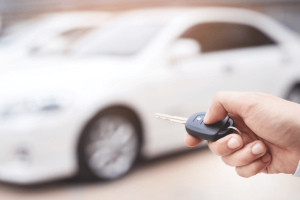
- The Savvy Promise
At Savvy, our mission is to empower you to make informed financial choices. While we maintain stringent editorial standards, this article may include mentions of products offered by our partners. Here’s how we generate income.
Distractions are everywhere in today's fast-paced world, including behind the wheel, but taking your eyes off the road can have devastating consequences. Distracted driving is a serious threat to road safety, putting you, your passengers, and others on the road at risk.
According to the Australian Automobile Association (AAA), around 16% of serious road accidents resulting in casualty are primarily caused by distraction. That’s why it’s crucial to know what the most common distractions while driving are, as well as how to avoid them, which you can learn all about with Savvy today.
Common causes of distracted driving
There are many ways for drivers to become distracted on the road, some of which you may not even realise you’re doing. Some of the most common distractions while driving include:
- Mobile phones: texting, talking (even hands-free) or checking social media diverts your attention in three ways: visually (taking your eyes off the road), manually (taking your hands off the wheel), and cognitively (focusing your mind on the conversation or message). According to the Transport Accident Commission (TAC), you’re ten times more likely to have an accident if you’re texting or browsing on your phone. Using your phone while driving is also illegal in some form in all jurisdictions in Australia.
- Music: loud music or fiddling with controls can take your focus away from the road, especially if you're singing along or trying to find a specific song.
- GPS: while GPS helps with navigation, programming it while driving or glancing down at the screen can steal your attention for crucial moments.
- Fatigue: becoming drowsy or falling asleep at the wheel is a significant contributing factor to major car accidents. The Centre for Accident Research and Road Safety – Queensland (CARRS-Q) reported in March 2018 that sleepiness contributes to between 20% and 30% of all deaths and serious injuries on the road.
- Food and drinks: eating or drinking while driving requires taking your hands off the wheel and your eyes off the road. Spills can also be a distraction. Although not illegal in all states and territories, you could still be fined and lose demerit points (depending on where you live) if you’re deemed to be driving without due care.
- Views from your window: beautiful scenery or interesting happenings outside can be tempting to look at, but taking your eyes off the road for even a second can be dangerous.
- Zoning out: something as simple as zoning out behind the wheel can also happen, particularly on long trips. A survey conducted by Brisbane law firm Murphy’s Law found that approximately 20% of respondents had zoned out while driving and wondered how they’d got somewhere.
- Passengers: talkative passengers, especially children or pets that require attention, can divert your focus from driving. This is prevalent among less experienced drivers, as Road Safety Education states that the likelihood of a novice driver being involved in a serious accident is doubled with two peer-aged passengers in the car.
Although there have been some crucial advancements in vehicle safety technology over the past few years, these features don’t serve as a replacement for attentive driving.
You should always be responsible behind the wheel and avoid these bad driving habits to help ensure your safety as well as that of your passengers and fellow drivers.
Why it’s dangerous to take your eyes off the road, even for a short time
You may not realise it, but taking your eyes off the road means your car is travelling blind for however long you’re distracted.
If you’re driving at 50km/h and look away for two seconds, your car will have travelled almost 28 metres without you watching the road. At 60km/h, this increases to over 33 metres, while on a country road at 100km/h, two seconds of distraction results in more than 55 metres of unsighted driving.
In the time you aren’t looking at the road, it’s easy to miss pedestrians, cyclists, animals, slowing or turning vehicles or a change of lights ahead of you. Because of this, it’s essential to do what you can to avoid falling into bad driving habits while driving.
Tips to avoid distractions while driving
- Put your phone in an unreachable place: this removes the temptation to check texts, emails or social media. Out of sight, out of mind! By placing your phone in a glove compartment or centre console, you eliminate the urge to handle it and keep your focus on the road.
- Don't pack food for your drive: eating and drinking require taking your hands off the wheel and your eyes off the road. Crumbs and spills can also be distracting. Because of this, you should avoid packing food for yourself or resolve to only eat as a passenger or once you’ve pulled over. Alternatively, eating before or after you drive is even safer.
- Set up your music or route before you start: inputting your destination into your GPS and choosing your playlist or podcast before you take off eliminates the need to interact with these functions while driving. Looking down at the screen or fiddling with controls diverts your attention.
- Pull over if you need to make adjustments: even minor adjustments to your music or GPS can be distracting. Pulling over to a safe location allows you to make these changes with your full attention before getting back on the road focused and ready to drive.
- Take a break if you're feeling drowsy: as mentioned, drowsiness impairs your reaction time and judgment. If you start to feel tired, pull over at a safe rest stop, grab a coffee or take a short nap to refresh yourself before continuing your drive. A well-rested driver is a safer and more focused driver.
What can you do if your passengers are distracting you?
- Communicate politely but firmly: the most important thing to do is to let your passengers know that their behaviour is distracting and could be dangerous. Explain your need to focus on the road for everyone's safety.
- Set expectations beforehand: if you know you'll have chatty passengers, especially children, establish ground rules before you start driving. Agree on quiet times or specific topics that won't require your full attention.
- Offer distractions for passengers: for younger passengers, bring along quiet activities like books, games, or tablets with downloaded content. This can help keep them occupied and reduce the need for your interaction.
- Take advantage of breaks: plan for breaks on longer trips. This allows passengers to stretch, chat and use the restroom without disrupting your focus while driving.
- Pull over if necessary: if the distraction becomes overwhelming, don't hesitate to pull over to a safe location. This allows you to address the issue calmly and refocus before getting back on the road.
Remember, your role as the driver is to ensure everyone's safety. Don't be afraid to politely assert your need for a focused driving environment.
Did you find this page helpful?
This guide provides general information and does not consider your individual needs, finances or objectives. We do not make any recommendation or suggestion about which product is best for you based on your specific situation and we do not compare all companies in the market, or all products offered by all companies. It’s always important to consider whether professional financial, legal or taxation advice is appropriate for you before choosing or purchasing a financial product.
The content on our website is produced by experts in the field of finance and reviewed as part of our editorial guidelines. We endeavour to keep all information across our site updated with accurate information.
Approval for car loans is always subject to our lender’s terms, conditions and qualification criteria. Lenders will undertake a credit check in line with responsible lending obligations to help determine whether you’re in a position to take on the loan you’re applying for.
The interest rate, comparison rate, fees and monthly repayments will depend on factors specific to your profile, such as your financial situation, as well others, such as the loan’s size and your chosen repayment term. Costs such as broker fees, redraw fees or early repayment fees, and cost savings such as fee waivers, aren’t included in the comparison rate but may influence the cost of the loan. Different terms, fees or other loan amounts may result in a different comparison rate.









